I was first drawn to Anna Kavan’s writing through her collection of wartime stories I Am Lazarus (1945) – the perfect antidote to the mindless cheerfulness of Blitz nostalgia. Kavan – the pacifist and anti-fascist – is having none of that delusion. But that’s another story. Twenty years later – in a time of Cold War tension and dread – she wrote Ice.
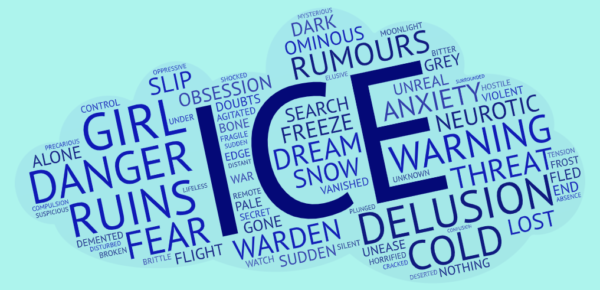 If you want to know what Ice is about you could start with this word cloud condensed from the words of the first fifty pages.
If you want to know what Ice is about you could start with this word cloud condensed from the words of the first fifty pages.
The world is doomed as a wall of ice moves inexorably toward the equator, the cold bearing down on the tropics. Along the way, desperate wars for survival destroy all hope of cooperation in the face of this existential threat.
Cities are in ruins, towns are deserted, the countryside laid waste. Climate disaster – the result of some human action – is slowly extinguishing life on earth. We never learn the precise cause of the crisis although it is caused by humans – the result of ‘a secret act of aggression by some foreign power’. The narrator hears rumor of ‘a steep rise in radioactive pollution, pointing to the explosion of a nuclear device’.
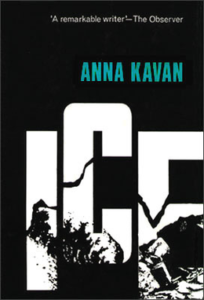 So that’s cheerful.
So that’s cheerful.
Here’s how it begins:
I was lost, it was already dusk, I had been driving for hours and was practically out of petrol. The idea of being stranded on these lonely hills in the dark appalled me, so I was glad to see a signpost, and coast down to a garage. When I opened a window to speak to the attendant, the air outside was so cold that I turned up my collar. While he was filling the tank he commented on the weather. ‘Never known such cold in this month. Forecast says we’re in for a real bad freeze-up.’ – Ice, Anna Kavan 1967.
That opening – terse, taut, and intriguing – conventional enough for a thriller – sets the tone. This could be Richard Hannay – returned from the colonies set on a wild chase to save the world. But there’s the unsettling word choice: Why is this nameless narrator “appalled” by the weather? Something’s off-kilter here. And indeed it is. Rather than the peril of the Black Stone and the mystery of the 39 steps, we have a post-nuclear apocalyptic world gripped in an existential terror of a new ice age.
Three nameless characters locked in an abusive and violent psychodrama are pitted against one another in an end-of-the-world scenario of polar ice moving inexorably towards them – destroying everything in its path, creating devastation and political chaos as it pushes the survivors toward the rapidly chilling tropics and certain extinction. It’s a story of obsession, possession, and victimhood,
And, yes, it’s unreal. Just pages in and this narrator sees things and knows things he could not.
An unearthly whiteness began to bloom on the hedges. I passed a gap and glanced through. For a moment, my lights picked out like searchlights the girl’s naked body, slight as a child’s, ivory white against the dead white of the snow, her hair bright as spun glass. She did not look in my direction. Motionless, she kept her eyes fixed on the walls moving slowly towards her, a glassy, glittering circle of solid ice, of which she was the centre. Dazzling flashes came from the ice-cliffs far over her head; below, the outermost fringes of ice had already reached her, immobilized her, set hard as concrete over her feet and ankles.
In Kavan’s novel we don’t know who these characters are – the narrator with his obsession with the “girl” and his struggle with his doppelganger – her husband, the ‘warden”. We don’t know the names of the countries or the towns and cities. It’s a familiar world turned terrifying by the destructive force of the great chill. The landscape is bleak – scarred by the cold, bleached free of humanity. Snow smothers the landmarks, roads are blocked, brutal desperate forces are unleashed. And the narrator is in obsessive pursuit to possess the “girl” he once wanted to care for and protect. Now she is married to a powerful military man, an artist, a brute, who polices the country with an army of thugs.
This is not your usual thriller or end-of-the-world drama – this is something else altogether. Perspectives shift, time and place become unmoored. Our narrator is not only unreliable but unhinged, panic-stricken and paranoid.
Early in the novel, the narrator tells us:
Reality had always been something of an unknown quantity to me. At times this could be disturbing.
Yes, indeed.
Ice is disorienting and disturbing but it makes for compelling reading; it casts a spell. It pulls you below the surface into an unsettled and unsettling world.
Great ice-cliffs were closing in on all sides. The light was fluorescent, a cold flat shadowless icelight. No sun, no shadows, no life, a dead cold. We were in the centre of the advancing circle. I had to try to save her. I called : ‘Come up here—quick !’ She turned her head, but without moving, her hair glinting like tarnished silver in the flat light. I went down to her, said : ‘Don’t be so frightened. I promise I’ll save you. We must get to the top of the tower.’ She seemed not to understand, perhaps did not hear because of the rumbling roar of the approaching ice. I got hold of her, pulled her up the slope : it was easy, she was almost weightless. Outside the ruin I stopped, holding her with one arm, looked round and saw at once that it was useless to go any higher. The tower was bound to fall; it would collapse, and be pulverized instantly under millions of tons of ice. The cold scorched my lungs, the ice was so near. She was shivering violently, her shoulders were ice already; I held her closer to me, wrapped both arms round her tight.
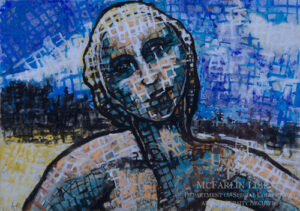
This is the stuff of nightmares when the blankets have slipped to the floor on a winter night.
Perhaps we have stumbled into Kavan’s personal universe – the troubled inner psyche of a woman whose life was beset by trauma and addiction.
We become lost in the harsh, dread beauty of that landscape – a wildly strange distortion of reality thinly veiled with the familiar to keep us alert and unsettled. There are no signposts or names to anchor us. Our narrator betrays us with his hallucinatory, fever-dream, roller coaster rides as he repeatedly searches for his quarry – brittle as glass, so pale, thin, and fragile – who had learned to be a victim in childhood.
As readers, we are lost in that world and lost in the grip of the narrator’s obsession and, like him, powerless in a world facing inevitable annihilation.
The description of the snow and ice take on a mesmerizing quality as Kavan repeatedly describes the journeys through the wintry world. Is this her account of her forty-year addiction to heroin (snow) – the drug that she believed enabled her to overcome her paralyzing depression and allow her to do the writing that kept her sane?
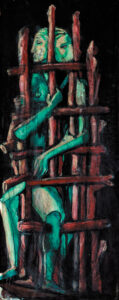
Perhaps it’s an allegory of the Cold War when the unthinkable – a nuclear exchange – sets off a climate catastrophe that brings about the mutually assured destruction of modern war. Perhaps it’s a medieval fable crossed with science fiction laced with pornographic psychodrama.
Whatever the interpretation, in the middle of an early summer heatwave it’s a relief to head back into Kavan’s big freeze. It’s not an easy novel to read but it is compelling and intriguing. The ice and cold are as relentless as the narrator’s obsession but if the novel gets you in its grip, it won’t let go. Kavan even manages to pull off a somewhat comforting ending.
This is the Hour of Lead –
Remembered, if outlived,
As Freezing persons, recollect the Snow –
First – Chill – then Stupor – then the letting go –
– Emily Dickinson
And then – along came the serendipity of this from the New Yorker (June 22, 2021):
Four Stories from the Russian Arctic
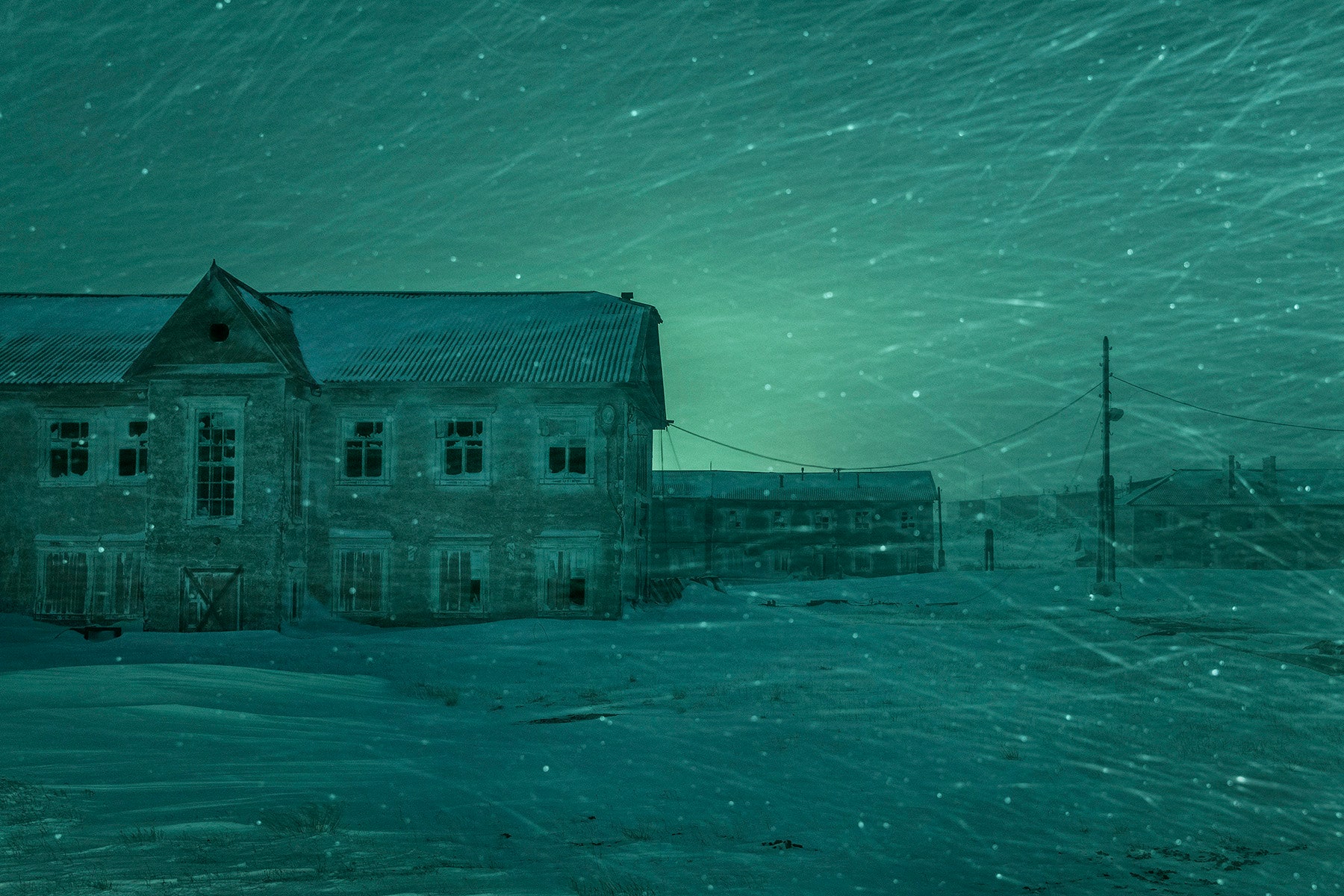



I had just used that same poem by Dickinson a few posts ago. It is the best description of grief I know.
Emily Dickinson was brilliant at distilling strong emotion into a few simple words, Off to look at your post again.
Brilliant post and comments!
Cheers Maria!
Clearly an early example of what’s now called cli-fi, from a time when we knew less, or rather nothing, about global heating and visions of a different kind of climate crisis were possible. But it still sounds a gripping story if we can imagine a sudden reversal of temperature change of weather patterns.
The science aspects of the novel seem more speculative and fantastic than actually scientific. But clearly, the climate apocalypse is a great backdrop to an allegory of the Cold War: How human folly – hunger for power and incapacity to cooperate – dooms us as a species. It also provides the chilling and doom-laden mise en scène for the three characters and their violent and abusive sadomasochistic psychodrama.
But that’s all part of what makes this novel so compelling and remarkable: It can be read in so many different ways.
Having lived through the Cold War and had vivid nightmares about mushroom clouds I can absolutely understand where she was coming from. And I seem to remember that astronomer Fred Hoyle, who died about twenty years ago, thought a new Ice Age was well overdue.
This is what Brian Aldiss (writing with David Wingrove) had to say about the context:
“The sixties, which began in hope, which were fired by an enthusiasm for mould-breaking and new life-styles, ended in pessimism and a sense of lost directions. The Vietnam War was escalating, the bills were piling up. No one knew where all the flowers had gone. Woodstock had vanished and Altamont was a dark scar on the memory. The Third World was dying all over again. Hippies who had dropped out found the need to drop back in again to pay the rent, raise kids, find status. It had been fun but it hadn’t been real – it didn’t last. Reality closed like a rat-trap. Technology had grown vastly while the young and would-be-young played their games – like some monstrous Frankenstein-creation biding its time in the mountainous wastes. Some writers saw this, of course, and spoke of it in metaphoric ways. One such was a woman who, like Mary Shelley, wrote science fiction without knowing it and, in doing so, created one of the great science fiction novels.”
Trillion Year Spree: The History of Science Fiction – Brian Aldiss with David Wingrove.
I’ve also read that she was influenced by the J.W. Dunne’s theories of time and dreaming. Dunne posited that our experience of time as linear is an illusion. He argued that past, present, and future were continuous (hello T.S.Eliot) in a higher-dimensional reality. He proposed the concept of higher time dimensions that he called “serial time.” In other words – just the usual thoughts of a military engineer and fly fishing enthusiast.
Excellent writing and how prescient she was. I wonder if anyone has written a bio of her. She sounds an interesting woman.
I’m not aware of a biography but it is possible to piece together a biographical portrait. And for certain her life is in her fiction – or at least the parts of it that I’ve read.
She does have a dedicated fan base (Doris Lessing was an admirer). Take a look at the Anna Kavan Society – https://annakavan.org.uk/ – founder Victoria Walker has written extensively about her. What drew me in first was her work first published in Cyril Connelly’s “Horizon” during WW2.
Thanks Josie I will follow up, as well as look out for her books in my favourite second hand book shop.
I think she is worth the effort, although I have not read all of her stuff. I just really like the alternative perspectives she provides. Refreshing. Distinctive. And odd.
I am off on the track in 5 mins!
There’s quite a bit online. Including Ice.